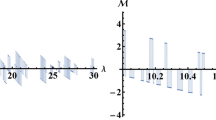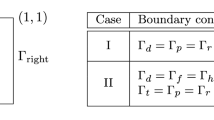Abstract
The present study deals with a second-order two-scale computational homogenization procedure for modeling deformation responses of heterogeneous materials at small strains. The macro to micro transition and the application of generalized periodic boundary conditions on the representative volume element (RVE) at the microlevel are investigated. The structure at macroscale level is discretized by the \(C^{1}\) two dimensional triangular finite elements, while the \(C^{0}\) quadrilateral finite element is used for the discretization of the RVE. The finite element formulations and the new proposed multiscale scheme have been implemented into the finite element software ABAQUS using user subroutines derived. Due to the \(C^{1}-C^{0}\) continuity transition, an additional integral condition on microlevel fluctuation field has to be imposed, as expected. The integration has been performed using various numerical integration techniques and the results obtained are compared in a few examples. It is concluded that only trapezoidal rule gives a physically based deformed shape of the RVE. Finally, the efficiency and accuracy of the proposed multiscale homogenization approach are demonstrated by the modeling of a shear layer problem, usually used as a benchmark in multiscale analyses.




















Similar content being viewed by others
References
Geers MGD, Kouznetsova VG (2010) Scale transitions in solid mechanics based on computational homogenization. Lecture Notes. Eindhoven University of Technology, Eindhoven
Hain M, Wriggers P (2008) Numerical homogenization of hardened cement paste. Comput Mech 42(2):197–212
Kouznetsova VG, Brekelmans WAM, Baaijens FPT (2001) An approach to micro-macro modeling of heterogeneous materials. Comput Mech 27:37–48
Mishnaevsky L Jr, Schmauder S (2001) Continuum mesomechanics finite element modeling in materials development: a state of art review. Appl Mech Rev 54:49–74
Nguyen VP, Stroeven M, Sluys LJ (2012) Multiscale continuous and discontinuous modelling of heterogeneous materials: a review on recent developments, Delft University of Technology
Doghri I, Ouaar A (2003) Homogenization of two-phase elasto-plastic composite materials and structures. Study of tangent operators, cyclic plasticity and numerical algorithms. Int J Solids Struct 40:1681–1712
Hassani B, Hinton E (1998) A review of homogenization and topology optimization II-analytical and numerical solution of homogenization equations. Comput Struct 69:719–738
Miehe C, Koch A (2002) Computational micro-to-macro transitions of discretized microstructures undergoing small strains. Arch Appl Mech 72:300–317
Kouznetsova VG (2002) Computational homogenization for the multi-scale analysis of multi-phase materials. Ph.D. Thesis, Technische Universiteit Eindhoven
Miehe C (2003) Computational micro-to-macro transitions for discretized micro-structures of heterogeneous materials at finite strains based on minimization of averaged incremental energy. Comput Methods Appl Mech Eng 192:559–591
Nguyen VD, Bechet E, Geuzaine C, Noels L (2012) Imposing periodic boundary condition on arbitrary meshes by polynomial interpolation. Comput Mater Sci 55:390–406
Toupin RA (1968) Elastic materials with couple stresses. Arch Ratio Mech Anal 11:385–413
Mindlin RD (1965) Second gradient of strain and surface-tension in linear elasticity. Int J Solids Struct 1:417–438
Kouznetsova VG, Geers MGD, Brekelmans WAM (2002) Multi-scale constitutive modelling of heterogeneous materials with a gradient-enhanced computational homogenization scheme. Int J Numer Method Eng 54:1235–1260
Luscher DJ, McDowell DL, Bronkhorst CA (2010) A second gradient theoretical framework for hierarchical multiscale modeling of materials. Int J Plast 26:1248–1275
Luscher DJ (2010) A hierarchical framework for the multiscale modeling of microstructure evolution in heterogeneous materials. Ph.D. Thesis, Georgia Institute of Technology
Xia ZC, Hutchinson JW (1996) Crack tip fields in strain gradient plasticity. J Mech Phys. Solids 44:1621–1648
Zervos A, Papanicolopulos SA, Vardoulakis I (2009) Two finite-element discretizations for gradient elasticity. J Eng Mech 135:203–213
Amanatidou E, Aravas N (2002) Mixed finite element formulations of strain-gradient elasticity problems. Comput Methods Appl Mech Eng 191:1723–1751
Matsushima T, Chambon R, Caillerie D (2002) Large strain finite element analysis of a local second gradient model: application to localization. Int J Numer Methods Eng 54:499–521
Shu JY, Fleck NA (1998) The prediction of a size effect in microindentation. Int J Solids Struct 35:1363–1383
Shu JY, King WE, Fleck NA (1999) Finite elements for materials with strain gradient effects. Int J Numer Methods Eng 44:373–391
Kouznetsova VG, Geers MGD, Brekelmans WAM (2004) Multi-scale second-order computational homogenization of multi-phase materials: a nested finite element solution strategy. Comput Methods Appl Mech Eng 193:5525–5550
Kaczmarczyk L, Pearce CJ, Bićanić N (2008) Scale transition and enforcement of RVE boundary conditions in second-order computational homogenization. Int J Numer Methods Eng 74:506–522
Bacigalupo A, Gambarotta L (2010) Second-order computational homogenization of heterogeneous materials with periodic microstructure. J Appl Math Mech 90:796–811
Forest S, Trinh DK (2011) Generalized continua and non-homogeneous boundary conditions in homogenization methods, plenary lecture. J Appl Math Mech 91:90–109
Dasgupta S, Sengupta D (1990) A higher-order triangular plate bending element revisited. Int J Numer Meth Eng 30:419–430
Abaqus/Standard 6.10.1 (2010) Dassault Systemes, Simulia
Akarapu S, Zbib HM (2006) Numerical analysis of plane cracks in strain-gradient elastic materials. Int J Fract 141:403–430
Lesičar T, Tonković Z, Sorić J, Čanžar P (2012) Multiscale modelling of deformation processes of nodular cast iron. In: Virag Z, Kozmar H, Smojver I (eds) Proceedings of the 7th International Congress of Croatian Society of Mechanical, Zadar, Croatia, pp. 163–164
Kaminski M, Figiel L (2001) Effective elastoplastic properties of the periodic composites. Comput Mater Sci 22:221–239
Acknowledgments
The authors express their gratitude to the Ministry of Science, Education and Sports of the Republic of Croatia for their financial support. The investigations described in this paper are also part of the project “Centre of Excellence for Structural Health” (CEEStructHealth) supported by the European Union under contract IPA2007/HR/16IPO/001-040513.
Author information
Authors and Affiliations
Corresponding author
Rights and permissions
About this article
Cite this article
Lesičar, T., Tonković, Z. & Sorić, J. A second-order two-scale homogenization procedure using \(C^{1}\) macrolevel discretization. Comput Mech 54, 425–441 (2014). https://doi.org/10.1007/s00466-014-0995-3
Received:
Accepted:
Published:
Issue Date:
DOI: https://doi.org/10.1007/s00466-014-0995-3




